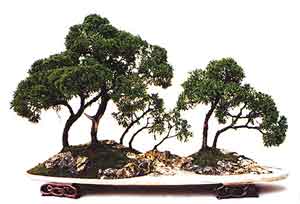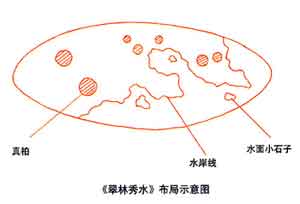
| GREEN FOREST AND BEAUTIFUL WATERS | by Zhao Xiang Chuen |
In the winter of 1995, I collected a large number of Pen Zai young shoots. Among these shoots I carefully selected seven real Cypress plants of different sizes, thickness and heights yet harmonious in their forms. I chose the largest and the most beautifully shaped cypress as the primary trunk, which is to be complemented by the other six trees. I then trimmed and wired the trees in order to create a model according to the basic requirements demanded for a good Penjing. Then I transplanted them in a rather shallow oval shaped purple sand pot (45cm x41cm). I tried to model them into a forest type Penjing of cypress. After four or five years of nurturing, adjusting and shaping, by the Fall of 1999 the Penjing had established well, exhibiting dense branches and leaves. The tree crowns were fully -grown and round and had joined together to form a unit. With this Penjing well established I named it "Cang Cui" meaning Emerald Green.
As real Cypress grows very rapidly, the plants very soon outgrew the pot. The pot was too small to accommodate the trees and also presented an unbalanced, less than satisfactory scene to view at. So in February 2001 I decided to remodel the penjing to one of wet and dry type. Firstly I selected a 79cm x 35cm oval shaped pot of white alum. As the trunks of cypress are not thick, a narrow shaped pot was preferred so as to emphasize the height of the trees. The pot when matched with black and white Ying Tek stones would show a distinct character. The veins of the stones with their harmonious colours would indeed create a very different form of penjing.
During the creation of this penjing, the trees were taken totally from the purple sand pot. Based on the original layout minor adjustments were made. The main portion of the plants was separated further away from the supplementary portion rendering a more open, comfortable yet not too loose an arrangement of the parts. The primary tree with its accompanying trees was positioned on the left while the secondary tree with its accompanying trees, on the right, the three shortest trees were positioned further behind linking up the primary and secondary portions. The smaller trees formed the distant backdrop and served to enhance the depth and width of the Penjing. The primary tree stood vertical while the others were inclined thus giving the scenery a more dynamic character. As a whole, the relative sizes of the trees were in a proper scale.
After transplanting I started cutting up the stones making sure I had
prepared more than required so that I would have more choice. I also
made sure these pieces came in different sizes, heights and thickness
and varied in form. I also used a sand-wheel to polish them to make
them look beautiful and natural. Through trial and error I repeatedly
attempted several approaches to the layout of the stones until I was
satisfied with the final arrangement. Then I marked the locations of
each piece. With white cement I secured them in place on the pot, making
sure the attachment look natural showing minimal artificial marks. Having
done with the cementing, I put five pieces of the stones on the dry
land portion: one on the left of the primary tree, one between the primary
tree and the small trees, one in front of the small trees, two on the
right of the secondary trees. I selected the piece of stone, which exhibits
outstanding characteristics for the major potion of the penjing. The
other pieces were smaller and look plain. The base of the stone must
be buried under the soil so as to secure them properly in place. While
arranging the stones we must also make sure to compact the soil in such
a manner as to reproduce a natural topography with its ups and downs.
Then came the procedure of beautifying the penjing by paving the soil
with moss. The moss helps to keep the loss of moisture to a minimum.
It serves also to link up the trees with the rocks as a unit. As the
leaves of real cypress are small and dense, the type of moss with short
leaves is therefore preferred. Then I had to do the trimming and wiring
to adjust further the posture of the trees and clean the surface of
the pot. Thus a wet and dry real Cypress penjing is finally completed.
(Refer to photos and diagrams)
(Translated from "Chinese Flower and Penjing " magazine
02:2)


Contents
Next: Luo Han Song ( Podocarpus macrophyllus)
Penjing
Suggestions? info@manlungpenjing.org